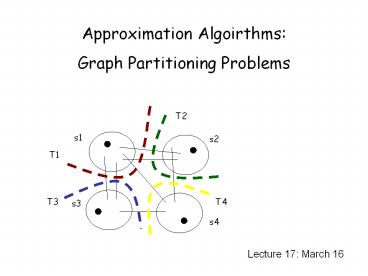Approximation Algoirthms: Graph Partitioning Problems - PowerPoint PPT Presentation
Title:
Approximation Algoirthms: Graph Partitioning Problems
Description:
a multiway cut is a set of edges whose removal. disconnects the terminals from each other. ... The sparsest cut problem asks for a set U which minimizes c(U)/dem(U) ... – PowerPoint PPT presentation
Number of Views:323
Avg rating:3.0/5.0
Title: Approximation Algoirthms: Graph Partitioning Problems
1
Approximation Algoirthms Graph Partitioning
Problems
T2
s1
s2
T1
T4
T3
s3
s4
- Lecture 17 March 16
2
Graph Partitioning Problems
General setting to remove a minimum (weight) set
of edges to cut the
graph into pieces.
- Examples
- Minimum (s-t) cut
- Multiway cut
- Multicut
- Sparsest cut
- Minimum bisection
3
Minimum s-t Cut
t
s
Minimum s-t cut minimum (weighted) set of edges
to disconnect s and t
Mininium s-t cut Max s-t flow
4
Multiway Cut
Given a set of terminals S s1, s2, , sk, a
multiway cut is a set of edges whose
removal disconnects the terminals from each other.
The multiway cut problem asks for the minimum
weight multiway cut.
s1
s2
s3
s4
5
Multicut
Given k source-sink pairs (s1,t1), (s2,t2),
...,(sk,tk), a multicut is a set of edges whose
removal disconnects each source-sink pair.
The multicut problem asks for the minimum weight
multicut.
s1
s4
t1
t3
t2
s3
s2
t4
6
Multicut vs Multiway cut
Given a set of terminals S s1, s2, , sk, a
multiway cut is a set of edges whose
removal disconnects the terminals from each other.
Given k source-sink pairs (s1,t1), (s2,t2),
...,(sk,tk), a multicut is a set of edges whose
removal disconnects each source-sink pair.
What is the relationship between these two
problems?
Multicut is a generalization of multiway cut.
Why?
Because we can set each (si,sj) as a source-sink
pair.
7
Sparsest Cut
Given k source-sink pairs (s1,t1), (s2,t2),
...,(sk,tk).
For a set of edges U, let c(U) denote the total
weight. Let dem(U) denote the number of pairs
that U disconnects.
The sparsest cut problem asks for a set U which
minimizes c(U)/dem(U).
In other words, the sparsest cut problem asks for
the most cost effective way to disconnect
source-sink pairs, i.e. the average cost to
disconnect a pair is minimized.
8
Sparsest Cut
Suppose every pair is a source-sink pair.
For a set of edges U, let c(U) denote the total
weight. Let dem(U) denote the number of pairs
that U disconnects.
The sparsest cut problem asks for a set U which
minimizes c(U)/dem(U).
S
Minimize
V-S
9
Sparsest Cut
This is related to the normalized cut in image
segmentation.
10
Minimum Bisection
The minimum bisection problem is to divide the
vertex set into two equal size parts and minimize
the total weights of the edges in between.
This problem is very useful in designing
approximation algorithms for other problems to
use it in a divide-and-conquer strategy.
11
Relations
Minimum cut
Multiway cut
Minimum bisection
Multicut
Sparsest cut
12
Results
Minimum cut
- Polynomial time solvable.
Multiway cut
- a combintorial 2-approximation algorithm
- an elegant LP-based 1.34-approximation
- an O(log n)-approximation algorithm.
- some evidence that no constant factor
algorithm exists.
Multicut
Sparsest cut
- an O(log n)-approximation algorithm based on
multicut. - an O(vlog n)-approximation based on semidefinite
programming. - some evidence that no constant factor
algorithm exists.
Min bisection
- an O(log n)-approximation algorithm based on
sparsest cut. - (this statement is not quite accurate but
close enough).
13
Relations
Minimum cut
2-approx
Multiway cut
Minimum bisection
O(log n)-approx
Multicut
Sparsest cut
O(log n)-approx Region Growing
O(log n)-approx
14
Multiway Cut
Given a set of terminals S s1, s2, , sk, a
multiway cut is a set of edges whose
removal disconnects the terminals from each other.
The multiway cut problem asks for the minimum
weight multiway cut.
s1
s2
This picture leads to a natural algorithm!
s3
s4
15
Algorithm
Define an isolating cut for s(i) to be a set of
edges whose removal disconnects s(i) from the
rest of the terminals.
- (Multiway cut 2-approximation algorithm)
- For each i, compute a minimum weight isolating
cut for s(i), say C(i). - Output the union of C(i).
How to compute a minimum isolating cut?
16
Analysis
s1
s2
Why is it a 2-approximation?
Imagine this is an optimal solution.
s3
s4
The (thick) red edges form an isolating cut for
s1, call it T1. Since we find a minimum isolating
cut for s1, we have w(C1) lt w(T1).
17
Analysis
T2
s1
s2
Why is it a 2-approximation?
T1
Imagine this is an optimal solution.
T4
T3
s3
s4
Key w(Ci) lt w(Ti)
- ALG w(C1) w(C2) w(C3) w(C4)
- OPT (w(T1) w(T2) w(T3) w(T4)) / 2
So, ALG lt 2OPT.
18
Bad Example
2
2
1.0001
1.0001
1.0001
1.0001
2
2
- OPT 4.0004
- ALG 8
19
Multicut
Given k source-sink pairs (s1,t1), (s2,t2),
...,(sk,tk), a multicut is a set of edges whose
removal disconnects each source-sink pair.
The multicut problem asks for the minimum weight
multicut.
s1
s4
t1
Can we use the idea in the isolating cut
algorithm?
t3
t2
s3
s2
t4
20
Bad Example
Algorithm take the union of minimum si-ti cut.
t1
s1
1
1
s2
t2
1
1
2.0001
..
..
1
1
sk
tk
- OPT 2.0001
- ALG 2k
21
Linear Program
for each path p connecting a source-sink pair
Separation oracle given a fractional solution d,
decide if d is feasible.
Shortest path computations between source-sink
pairs.
22
Rounding
for each path p connecting a source-sink pair
Intuitively, we would like to take edges with
large d(e).
Fractional solution could be very fractional.
Look at a vertex solution.
Dont know what to say

